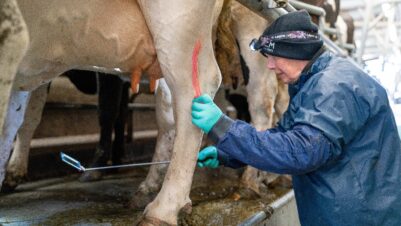Schmallenberg virus (SBV) was first identified in the Netherlands, Germany and Belgium during 2011, when a spate of undiagnosed cases of diarrhoea, high temperature and milk drop in adult dairy cows was detected. But over the years, it has become widespread in Europe, extending to Turkey, Greece, Russia and countries in eastern Europe. Although SBV primarily affects sheep, cattle and goats, it has been detected in other ruminants, such as llama and deer species, but no clinical disease has been reported in these animals. One suggestion is that infected but non-symptomatic deer may affect the spread of this disease.
Although Schmallenberg virus primarily affects sheep, cattle and goats, it has been detected in other ruminants, such as llama and deer species, but no clinical disease has been reported in these animals
During the novel outbreak of the virus in the UK, Farmer’s Weekly stated that industry organisations were describing the disease not only as worse than originally expected but also as “worse than bluetongue” (Alderton, 2013), highlighting the potential impact of the disease. But what is the Schmallenberg virus? How is it transmitted? What are the clinical signs you should be looking out for? And, most importantly, how can veterinary professionals help control the disease?
Rudolf Reichel, APHA’s small ruminant expert group lead, tackled these questions during this year’s Official Vet Conference online – read on for the answers!
How is the Schmallenberg virus transmitted?
SBV is similar to the Akabane and Shamonda viruses, which are transmitted by biting midges. The midges involved in the transmission of the Schmallenberg virus are Culicoides spp of the obsoletus complex. Culicoides spp, the smallest blood-feeding insects (at 2 to 4mm) in the world, are highly abundant with a near worldwide distribution and are also particularly attracted to cows. No other insect vectors for this virus have been found so far.
If temperature conditions are ideal, the transmission process is very efficient. Extrinsic incubation inside the insect occurs within 4 to 20 days, depending on the temperature. A single bite from an infected adult vector is sufficient to transfer SBV to a susceptible host. The host will then develop viraemia (over one to six days) and become infective to vectors after only one to four days.
Although theoretically possible via semen (with virus-positive semen detected at low frequency for up to three months), no animal-to-animal transfer has been found other than that of the pregnant dam to offspring in utero. There is currently no evidence of oral infection via milk or ingested amniotic fluid/placenta; embryos, however, are of an uncertain transmission risk.
What is the seasonality and spread of Schmallenberg?
As SBV is vector-borne, its spread is closely linked to the number and distribution of midges which are, in turn, affected by the weather and climate. Midges are active at dusk and dawn between April and November, but numbers typically peak in May and September and drop rapidly in the winter when there are frosts. However, some transmission does occur over mild winters and in micro-climates (such as inside sheds).
| It is important to note that the autumnal peak in midge activity can coincide with tupping and pregnancy, and that some infection can occur during mid-winter housing in cattle. |
It is thought that the original outbreak of SBV in January 2012 was caused by infected midges windblown from mainland Europe to the south-eastern counties (Norfolk, Suffolk and East Sussex), where deformed lambs were first detected. Although the distribution recorded for the 2012/13 outbreak appeared to begin in the southeast before moving north and inland, it is crucial to note that this could be slightly misleading as it did not take into account when farmers were breeding their stock.
After the initial UK outbreak, which had a wide distribution, the disease apparently “disappeared”, perhaps due to the rapid high seropositivity and colder weather, which reduced transmission. However, it re-emerged in 2016, so the suggestion is that the disease could have been reintroduced from Europe by a similar mechanism. However, recent research has noted that the three main outbreaks of SBV in Great Britian since 2011 have been caused by closely related but distinct lineages of the virus. Re-emergence of the virus, presumably from undetectable circulation during intervening years, instead of reintroduction from Europe is, therefore, likely.
What are the clinical signs of Schmallenberg disease?
Acute disease presents as diarrhoea, pyrexia and milk drop in some adult dairy cows and goats, but this is rarely recorded in sheep, if at all. Deformed stillbirths and abortions are the principal issue with SBV and can include:
- Early embryonic losses, seen with high barren rate
- Abortions and stillbirths without deformities, eg mummified foetus
- Deformed offspring with
- Brain lesions
- Twisted, fused limb joints
- Twisted spines
- Deformed skulls or jaws
- “Dummy” presentation and nervous signs – including blindness, ataxia, recumbency, an inability to suck and, sometimes, seizures – or weak offspring
Foetal deformities vary depending on when the infection occurred. Interestingly, in sheep, only one lamb may be affected in a multiple birth, but this phenomenon has yet to be explained. There is also the possibility of embryonic losses and temporary infertility in breeding males.
The large variation of clinical disease seen on individual farms following natural infection suggests that other factors may be involved
The large variation of clinical disease seen on individual farms following natural infection suggests that other factors may be involved. The health of the placenta, extent of placental development, viral challenge/load and foetal organ maturity at infection have been suggested as potential factors.
What is the timing for acute infection in pregnant animals leading to congenital deformities?
Timing of infection has a significant impact on the severity of congenital deformities present, with infection between day 28 and 60 of gestation (one to two months) for sheep and day 80 and 180 for cattle (two-and-a-half to six months) causing pathology. When later infections occur in cattle, the disease presents as central nervous system inflammation (including nervous signs) instead of deformity.
SBV has, however, been known to colonise the placenta between 45 and 60 days in sheep, with infection persisting for up to 150 days in the placenta.
| As there is a long period between acute infection and the birth of a deformed calf/lamb, it is possible for the initial infection to be missed. |
How do we diagnose Schmallenberg?
Clinical signs and pathology are the cornerstones of diagnosis for SBV. There is a possibility of free testing, so sharing photographs and discussing cases with a diagnostic laboratory is advised.
When sending a case for testing with APHA, the whole carcass should be submitted. If this is not possible, samples of the below should be sent instead:
- Amniotic fluid scrape or piece of fresh umbilicus or brainstem if fluid cannot be obtained
- Foetal fluid (for foetal SBV antibody testing)
- Maternal blood sample (for SBV serology) if possible
When SBV tests are negative, a 1cm cube of fresh brain or the entire fixed brain and spinal cord (from the cervical cord for forelimb arthrogryposis or lumbar for hindlimb arthrogryposis) can be useful for confirmation and differential diagnosis.
During post-mortem examinations of offspring born alive/dead or aborted following intra-uterine infection, certain pathologies can be indicative of infection with SBV:
- Arthrogryposis (bent limbs and fixed joints) and muscle wastage in the spine, limbs and joints
- Brain deformities (hydranencephaly) and spinal cord damage
- Nervous signs and “dummy” presentation
- Brain and spinal cord lesions, wherein fluid-filled pockets develop instead of brain tissue
- Diminished spinal cord diameter and under- or undeveloped cerebellum
Testing can be complicated as intra-uterine bluetongue virus can also present with hydranencephaly. However, Schmallenberg can be ruled out when there is the presence of extra or missing body parts (heads/limbs) and abnormalities of the internal organs or genitals.
How can veterinary professionals help control Schmallenberg virus?
1. Vector control
When it comes to reducing contact between animals and midges, there is, unfortunately, no sure-fire way to protect all animals or prevent bites.
As Culicoides spp breed in damp organic matter, such as soil, leaf litter and animal dung (common in farmland), draining bodies of water will not help reduce midge populations. Further, removing larval habitats (eg clearing faeces) and setting up traps do not affect Culicoides colonies.
While repellents (DEET) do repel these species, this type of protection is transient, and therefore does not practically affect SBV transmission in field. Insecticides, though providing persistent protection, are not recommended. This is because anecdotal evidence shows that these pour-on varieties, despite killing Culicoides in laboratory settings, do not appear to affect transmission in field.
2. Animal husbandry
According to impact surveys of the 2016/17 and 2023/24 outbreaks of SBV, flocks with earlier mating and lambing dates were more likely to experience higher SBV-related lamb losses (Stokes et al., 2018; Tarlington et al., 2024). If practical, delaying pregnancy until later in the year could lower the risk of contracting SBV.
Flocks with earlier mating and lambing dates were more likely to experience higher SBV-related lamb losses
These surveys also revealed that hill flocks were less likely to experience SBV-related lamb losses than lowland flocks, most likely because they are more exposed and thus less likely to have high midge concentrations. Therefore, veterinary professionals can recommend that farmers take advantage of any windy, high-altitude and/or cold grazing areas.
While it may seem practical at first, housing animals as a protective method may be counterproductive. Not only does this concentrate animals – a food source – in a single, enclosed location but Culicoides spp can enter sheds and stables, especially in the autumn and even in the winter. Furthermore, creating vector-proof accommodation is a significant challenge, involving ventilation (positive air pressure), consideration of the welfare implications and screening with mesh of an aperture smaller than 0.5mm, which may cause overheating and other health problems.
Maintaining a mechanical airflow at over 3m/s – the speed necessary to inhibit biting – within accommodation has been achieved with success in the Netherlands. So, if animals must be housed, this could be a possibility with the right shed and equipment.
Safety during transportation is crucial as midges can “hitch a lift” on vehicles. Good biosecurity, including the removal of any organic material that may attract midges and regular cleaning of trailers, is key. Considering moving animals at times of lowest biting risk (during daytime, instead of dawn/dusk) is also useful.
3. Vaccination
Once infected, animals become immune. Although this immunity may be lifelong in some individuals, it is generally considered protective for at least three to four years. As not all individuals within a flock/herd are bitten by the vector, some individuals are left unexposed, which explains the re-emergence of SBV every five or so years within the UK. Because of this cycle, despite the fact that vaccinations work very well, it is not economically viable for pharmaceutical companies to stock them.










